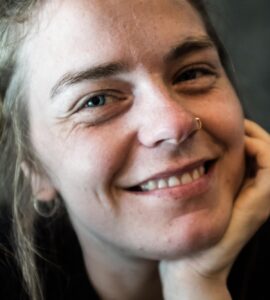In May this year, Sara Blichner started as a post-doctoral researcher at the Department of Environmental Science, Stockholm University. Earlier, when working on her PhD in meteorology at the University of Oslo, she had been in contact with Ilona Riipinen, and Stockholm University became an attractive next step. She has contributed to the latest IPCC report and is now involved in the EU’s FORCeS project, which tries to understand and reduce the long-standing uncertainty in anthropogenic aerosol radiative forcing.

Sara’s main research focus is on aerosols, particularly biogenic organic aerosols which are separated from the anthropogenic ones. In plain language: all trees emit gases which react in the atmosphere and produce aerosols, resulting in a cooling effect on the climate. When the temperature is rising, vegetation tends to produce more of these gases, resulting in more aerosol and more cooling. Sara wants to follow this chain more in detail, in order to make the organic aerosol component in climate models more precise.
She describes a normal work week with “a lot of programming, running tests, waiting for results, and analysing the output.” And meetings. Even though she would like to go on field trips like many of her colleagues, her contribution to research is elsewhere. “Actually, I can do most of my work with an internet connection,” she says.
So far, she hasn’t been to Stockholm, and the zoom-interview takes place from her base in Helsinki.
“But in the next couple of weeks, I hope to be able to move to Stockholm,” she says.
Contribution to the latest IPCC report
Sara recently contributed to the IPCC’s first part of the Sixth Assessment Report, Climate Change 2021: The Physical Science Basis., particularly on the climate forcing caused by aerosols.
“My ex-supervisor was lead author of chapter six, and my work was mainly to process data and produce figures for that chapter. Back when the last IPCC report was released in 2013, I was studying mathematics and was a little unsure about my future. It was while reading that report that I decided to change fields to climate science. And now I am really quite proud to be a contributing author to the new one!”
She got involved in the IPCC report in 2018, running parallel with her PhD thesis.
“It was a really interesting process, with the iterations and to see how the report evolved. It is a very important piece of work and involves a lot of impressive people. This report becomes the basis and frame of reference for policy making on questions of vital importance for humanity. I definitely want to be a part of it again, if I can,” she says.
Part of the EU’s FORCeS project
The FORCeS project brings together 20 European research teams, including several Bolin Centre scientists, in an effort to reduce uncertainty in aerosol effects on climate. What is your role in FORCeS?
“I work with an Earth System Model and we want to incorporate as many features of organic aerosol as possible into the model. But we must be smart though. Too many variables will slow the simulations down too much and render the model impractical, so we need to choose the essential ones. It is also really cool to be part of this EU-project with so many interesting people and institutions involved.”
She also appreciates the width at the Department of Environmental Science, with people engaged in both lab, campaigns and modelling on different scales.
Looking forward, what is the plan for the next five years?
“I really want to stay in climate science, keep on doing science and teach. And with climate science, we are nowhere near done, there are lots of questions left to investigate.”
She believes that when policy catches up with climate science, there will be a need for different kinds of research questions.
“If you look at climate policy now, in a way the only advice science needs to give is to start cutting emissions already, focusing primarily on CO2 and methane. And this we’ve already known for quite a while and there is no new science needed. But in the future, as we start to see real climate action, I think it will become clear that a lot more intricate understanding is needed. For example, determining the net effect of planting a forest involves the effects of changing albedo (reflectivity of the surface), aerosol, changes to meteorology (winds/rainfall) and carbon storage”
“Some of these new questions are already here, and they are going to be even more relevant to answer,” she concludes.
A version of this article was originally published on the Bolin Centre website

